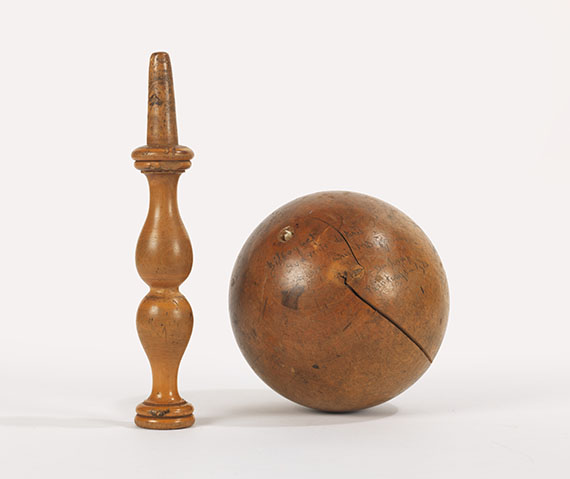Dictionary


Surrealism
The meaning of the term Surrealism goes back to the poet Guillaume Apollinaire (1917), it came up in the first half of the 20th century in the context of new cognitions of psychoanalysis. The ideas of the unconscious inspired surrealist artists so much that they wanted to visualize the unconscious as the actual reality in their pictures. Dream and reality were supposed to merge - the actual meaning of the word "surréalisme" (frz. "sur" = beyond) literally refers to what is beyond Realism or reality.
Surrealism formed to be a movement under the guidance of the French writer and critic André Breton (1896-1966) in Paris as of 1921. His programmatic "Manifeste du Surréalisme" (Manifesto of Surrealism) was released in 1924. Surrealism, at first less a style than a spiritual-political mindset, asked for an annihilation of the borders between dream and reality, illusion and reason, the subjective and the objective, as a "psychic automatism". It was based on Magic Realism, Symbolism, Pittura Metafisica and Dadaism.
Topics of surrealist works were the world of images from dreams, inebriation and hypnosis, that led to fantastic innovations. In terms of style, the objects, especially in Veristic Surreealsim, were depicted in an exaggerated clear and often grotesquely blurred manner, colors are cool and clear, the objects are isolated from their original contexts and rearranegd in new relations, so that dream and reality seem to become indistinct. Besides a drastic realism of the detail, the Absolute Surrealism, which is based on Automatism, is a rather spontaneous and non-representational variant that mirrors the unconscious.
Surrealism made for great achievements regarding the enhancement of the art term: collage, frottage and other new techniques and styles were introduced, new materials were used and film and photography played an important role. The technique of "Automatism" ("écriture automatique" and "dessin automatique" = automatic writing and automatic drawing) were the keywords of gestural post-war abstraction.
Among the most important artists of international Surrealism were Hans Arp, Leonora Carrington, Salvador Dalí, Paul Delvaux, Oscar Dominguez, Marcel Duchamp, Edgar Ende, Max Ernst, Alberto Giacometti, Frida Kahlo, René Magritte, André Masson, Robert Matta, Joan Miró, Richard Oelze, Meret Oppenheim, Wolfgang Paalen, Pierre Roy, Kay Sage, Yves Tanguy and Mac Zimmermann.
The meaning of the term Surrealism goes back to the poet Guillaume Apollinaire (1917), it came up in the first half of the 20th century in the context of new cognitions of psychoanalysis. The ideas of the unconscious inspired surrealist artists so much that they wanted to visualize the unconscious as the actual reality in their pictures. Dream and reality were supposed to merge - the actual meaning of the word "surréalisme" (frz. "sur" = beyond) literally refers to what is beyond Realism or reality.
Surrealism formed to be a movement under the guidance of the French writer and critic André Breton (1896-1966) in Paris as of 1921. His programmatic "Manifeste du Surréalisme" (Manifesto of Surrealism) was released in 1924. Surrealism, at first less a style than a spiritual-political mindset, asked for an annihilation of the borders between dream and reality, illusion and reason, the subjective and the objective, as a "psychic automatism". It was based on Magic Realism, Symbolism, Pittura Metafisica and Dadaism.
Topics of surrealist works were the world of images from dreams, inebriation and hypnosis, that led to fantastic innovations. In terms of style, the objects, especially in Veristic Surreealsim, were depicted in an exaggerated clear and often grotesquely blurred manner, colors are cool and clear, the objects are isolated from their original contexts and rearranegd in new relations, so that dream and reality seem to become indistinct. Besides a drastic realism of the detail, the Absolute Surrealism, which is based on Automatism, is a rather spontaneous and non-representational variant that mirrors the unconscious.
Surrealism made for great achievements regarding the enhancement of the art term: collage, frottage and other new techniques and styles were introduced, new materials were used and film and photography played an important role. The technique of "Automatism" ("écriture automatique" and "dessin automatique" = automatic writing and automatic drawing) were the keywords of gestural post-war abstraction.
Among the most important artists of international Surrealism were Hans Arp, Leonora Carrington, Salvador Dalí, Paul Delvaux, Oscar Dominguez, Marcel Duchamp, Edgar Ende, Max Ernst, Alberto Giacometti, Frida Kahlo, René Magritte, André Masson, Robert Matta, Joan Miró, Richard Oelze, Meret Oppenheim, Wolfgang Paalen, Pierre Roy, Kay Sage, Yves Tanguy and Mac Zimmermann.
Offers for Surrealism
Headquarters
Joseph-Wild-Str. 18
81829 Munich
Phone: +49 89 55 244-0
Fax: +49 89 55 244-177
info@kettererkunst.de
Louisa von Saucken / Undine Schleifer
Holstenwall 5
20355 Hamburg
Phone: +49 40 37 49 61-0
Fax: +49 40 37 49 61-66
infohamburg@kettererkunst.de
Dr. Simone Wiechers / Nane Schlage
Fasanenstr. 70
10719 Berlin
Phone: +49 30 88 67 53-63
Fax: +49 30 88 67 56-43
infoberlin@kettererkunst.de
Cordula Lichtenberg
Gertrudenstraße 24-28
50667 Cologne
Phone: +49 221 510 908-15
infokoeln@kettererkunst.de
Hessen
Rhineland-Palatinate
Miriam Heß
Phone: +49 62 21 58 80-038
Fax: +49 62 21 58 80-595
infoheidelberg@kettererkunst.de
We will inform you in time.




